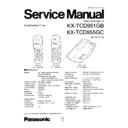Panasonic KX-TCD951GB / KX-TCD955GC Service Manual ▷ View online
42
KX-TCD951GB/KX-TCD955GC
CHECK PROCEDURE (HANDSET)
TEST EQUIPMENT REQUIRED AND EQUIPMENT SETUP
(a) CMD60
(b) Power Supply (12V 1A)
(c) Digital MultiMeter
(d) Oscilloscope
(e) Frequency Counter
(f) Computer (PC): Set the computer to the MS-DOS mode. Type: SET-COM1.
(g) Test software (Batch Files)
Connect a 3.9V supply to the board J3 (+), J4 (–).
Connect the computer serial link to the Test Fixture J6 (+), J8 (–).
INITIAL POWER + BBIC TESTS
1. Turn on the 3.9V supply.
2. Press the “Power-on” button.
3. Check for a “beep” and approx 80 mA current on the 3.9V supply.
4. Check the 3.0V supply voltage (TP2). It must be 3.0 ± 0.2V.
5. Connect RFCLK (TP56) to CH.1 on the scope.
6. Check if the clock waveform is 10,368.000 kHz.
7. Send batch file “SELF TEST”.
SET CLOCK FREQUENCY
1. Send batch file “FIX FREQ”.
2. Connect RFCLK (TP56) to the frequency counter.
3. Send batch file “SET FREQ nn” to set the clock frequency. The default value of nn is 80. Increase the value to
increase the frequency. The clock frequency must be 10,368.000 kHz ± 0.02 kHz.
TEST MODE:
MANUAL TEST
MODULE TEST
CONFIG MENU
MODULE TEST
PP
RFPI:
DUMMY SLOT:
DUMMY CARRIER:
TRAFFIC SLOT:
TRAFFIC CARRIER:
RF LEVEL:
TRIGGER:
EXP. POWER:
SIGN
RF GENERATOR
0000000010
0
5
2
5
– 55 dBm
RISING SLOPE
30 dBm
SCRAMBLE:
FREQ:
DEVIATION:
SIGNAL:
RF LEVEL:
OFF
1888.704 MHz
288 kHz
00001111
– 40.7 dBm
43
KX-TCD951GB/KX-TCD955GC
QUICK Tx CHECK
1. Set the CMD60 to MODULE TEST.
2. Send batch file “H”.
3. Confidence check of Power (NTP): must be +20 to +25 dBm.
LOOPBACK TEST
1. Set the CMD60 to MANUAL TEST.
2. Set the CMD60 TRAFFIC CARRIER to 5.
3. Send batch file “TESTMODE”.
4. On the CMD60 press “SETUP CONNECT”.
5. Check Power (NTP): must be +20 to +25 dBm.
6. Press MODULATION.
7. Set Data Type to “Fig.31”.
8. Check the Frequency Drift: must be 0 ± 45 kHz/ms.
9. Check the Frequency Offset: must be 0 ± 40 kHz.
10. Check the Deviation (Max. ± B Field) with Data Type “Fig.31”: must be 280 to 370 kHz.
11. Press MENU UP.
12. Press POWER RAMP
13. Check the Burst fits mask.
14. Press MENU UP.
15. Press BER.
16. Note the Sensitivity (reduce the RF LEVEL for a BER of approx. 1000ppm) : RF LEVEL must be < – 88 dBm.
17. Press MENU UP.
18. Press BEARER RELEASE.
(Note: These tests can be repeated on Traffic Carriers 0 and 9.)
44
KX-TCD951GB/KX-TCD955GC
TROUBLESHOOTING GUIDE
HANDSET: DOES NOT OPERATE.
Yes
No
Yes
No
Yes
No
1
No
Yes
No
Check the battery terminal, PCB
and battery contact.
and battery contact.
Check X1 and the surrounding
area.
Check the IC1 soldering.
area.
Check the IC1 soldering.
Disconnect the AC adaptor of
the base unit. Are clock
waveforms output to IC1 pin 10
of the handset?
the base unit. Are clock
waveforms output to IC1 pin 10
of the handset?
Check the power of IC1.
Is it 3.0V?
Is it 3.0V?
Supply 3.6V voltage to the PCB
from an external source.
from an external source.
Defective battery contact.
Replace the batteries with fully
charged ones, and set the power
switch to ON. Does " " flash
on the LCD screen of the
handset?
charged ones, and set the power
switch to ON. Does " " flash
on the LCD screen of the
handset?
No
Check the battery voltage.
Is it more than 3.6V?
Is it more than 3.6V?
Does " " remain lit, and is the
handset number displayed?
handset number displayed?
Set the handset power switch to
ON. Does " " flash on the LCD
screen of the handset?
ON. Does " " flash on the LCD
screen of the handset?
Handset: Insert the batteries.
Base unit: Connect the AC adaptor and telephone cord.
Base unit: Connect the AC adaptor and telephone cord.
2
3
Click on the first or last page to see other KX-TCD951GB / KX-TCD955GC service manuals if exist.

